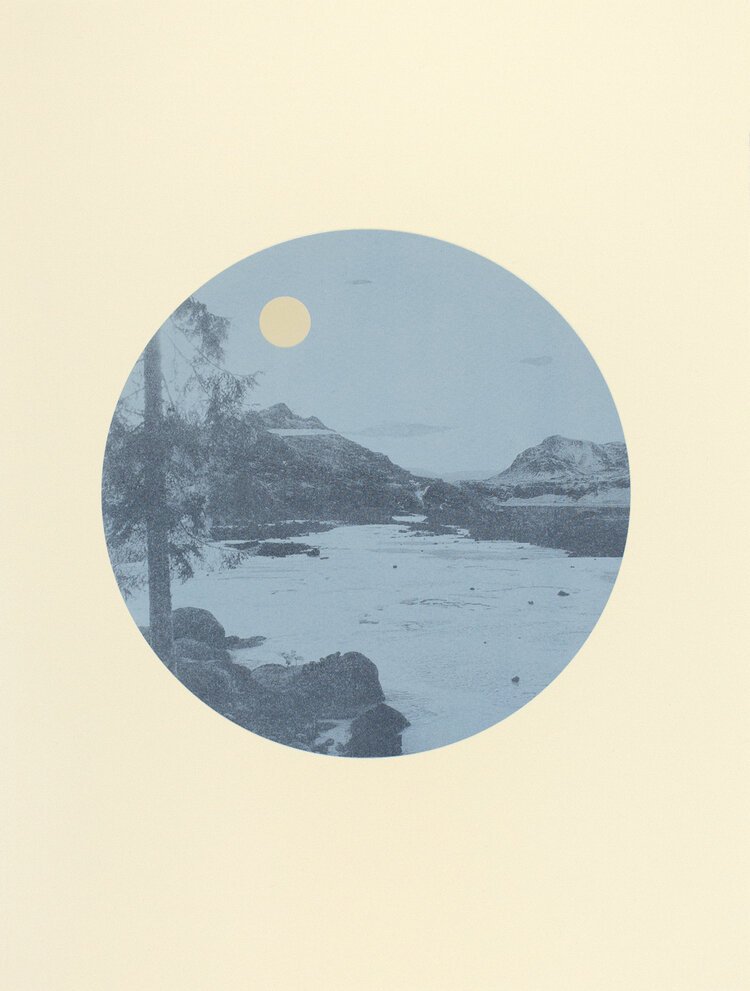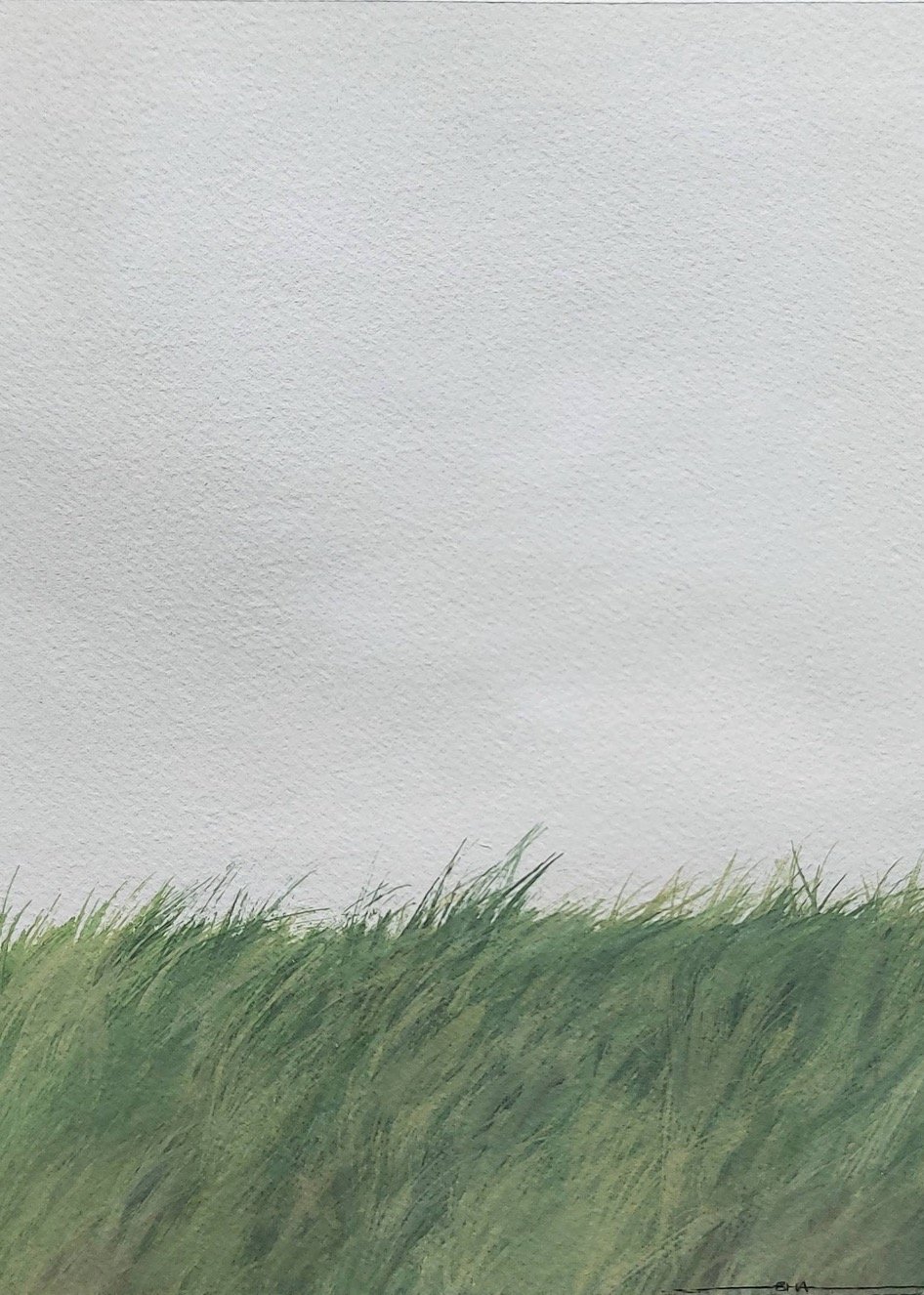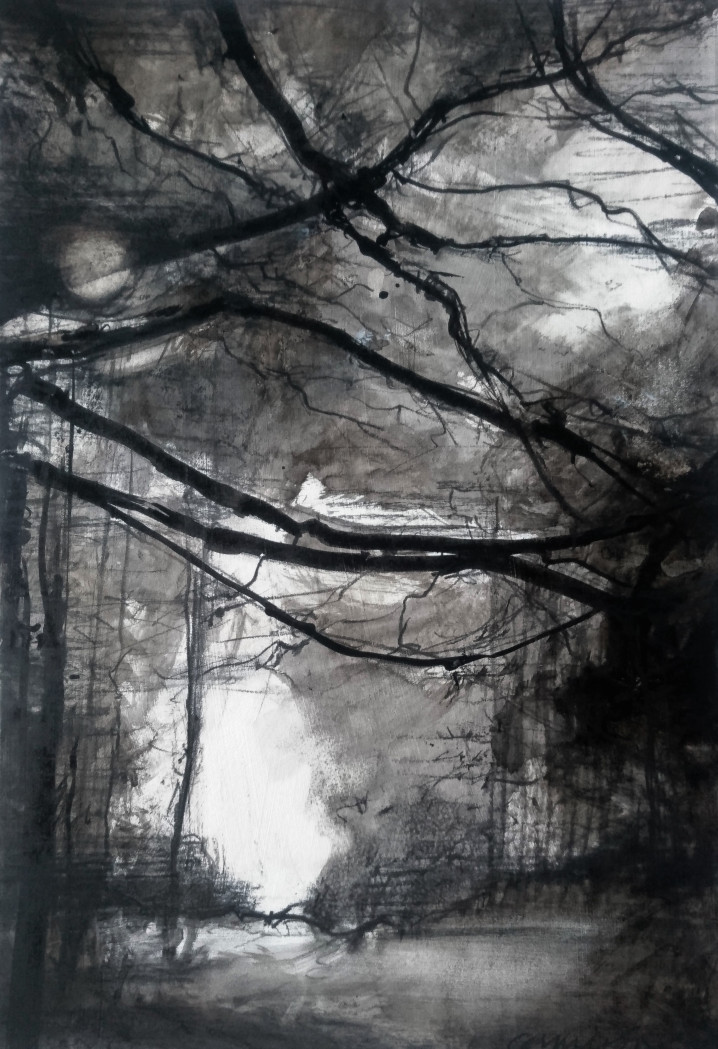I'm a curious type; I like to know what informs an artist. Who or what do they look to for inspiration? How do they work? Each month I will be asking an artist I admire a few questions, this month is Sherrie-Leigh Jones.
Falls at Dusk, 38.5cm x 28.5cm, hand finished screenprint with graphite powder and ink
Sherrie-Leigh, your landscape, travel and nature inspired prints are enchanting. I’m curious to know how you came to print making as your primary method of art making?
When I left art college, I actually started a degree in illustration but didn’t stay on the course that long as it wasn’t what I thought it was going to be, and I felt a bit pigeon holed working to briefs. A while after, I moved to Brighton to start a foundation degree in fine art where I experimented with different ways of working and printmaking again, particularly screenprinting as I really enjoyed the process - that’s when I really got into printmaking more and it became my chosen method of creating.
What is your favourite print making method?
Through experimenting, I naturally became drawn to screenprinting for the way in which I create my work.
Moon Over The Plain, 38cm x 28.5cm, screenprint with graphite powder and ink
Midsummer Moon, 38cm x 28.5cm, screenprint with graphite powder and ink
I particularly love your Chinese and Japanese inspired work, what first prompted you to create a series inspired by Chinese and Japanese art forms?
You can easily get lost looking at all the different elements and tiny details in the landscapes, the different qualities of techniques with painting and printmaking from the softness of the brush strokes bringing a calmness. I think for me, they create that sense of escapism that I hope my work brings to people.
Are there other print techniques, materials or ways of working that you’d like to try?
I’ve experimented with photo etching, mono printing, cyanotypes and other print techniques but always end up coming back to screenprint. Last year I played around more with the idea of chine collé, which I think I’ll come back to at some point and I’d also like to try risograph printing, as well as printing on wood again and perhaps also bringing an element of embossing back to some prints - I just never seem to have enough time for all my ideas!
Calm White River, 102cm x 68cm, cellulose transfer print on Japanese paper
You studied BA (Hons) Fine Art Printmaking at University of Brighton, what drew you to study at Brighton and how did the course affect your practice?
The foundation degree was for two years, after which you could transfer to a BA to top it up. There aren’t that many specialist printmaking degrees in the UK and Brighton’s such a vibrant and diverse city by the sea, full of creativity that I loved, so I decided to stay as the University is one of the few that offers a printmaking course. As I’d already grown a love for screenprinting, I mainly stuck to that which I combined with digital print and collage. The course allowed me time to experiment even more with the possibilities of screenprint and the materials I could use. It’s also where I really developed the idea of creating imagined environments and landscapes.
Take us through a ‘day in the life’ - what does a typical day involve?
It depends what I have going on, no two days are generally the same, but I do try and have some sort of routine. Most days I’ll get up and workout, sort myself out and then head in the studio or to the print studio. Usually I’ll check emails first in the morning and reply to any that need a response sooner. I’ll then go to the post office or drop any prints off at the couriers. I try and do some collaging for a good few hours before I stop and do anymore admin late afternoon - emails, ordering materials and packaging, updating my website etc. and I try and remember to post on social media during the day as well. I’ll then pack any prints up before I finish for the day and try and go for a walk. If I’m at the print studio, I’ll be stripping, coating and exposing screens before sorting paper, mixing inks and printing my collages. Then I’ll come back later on and reply to emails, pack prints, arrange couriers etc. Some days and weeks are more creative than others, some just end up being more admin heavy.
Emerald Mount, 20.5cm x 25.5cm, cellulose print on Japanese paper
Emerald Mount (West), 20.5cm x 25.5cm, cellulose print on Japanese paper
What artists (living or dead) inspire you?
So many, but to name a few… Hasui Kawase and Koho Shoda, probably my favourite of the Shin-Hanga artists… Katie Paterson, James Turrell and Raqib Shaw. I also love romanticism, so people like Caspar David Friedrich and The Hudson River School artists.
Tell me about your studio or creative space.
I work between my home studio, which at the moment I share with my husband, and at North Star Printmaking studio in Brighton. l'm always gathering imagery and taking photographs on my travels, walks and when I'm just out and about if something catches my eye. I then use analogue and digital collage, which I work on in my home studio before taking them into the print studio to screenprint. It's nice to have a balance of working in my own space and then sometimes being around other printmakers in the print studio… and I also feel so lucky to have the sea on my doorstep if I get a bit of a block to go for a walk or just need a break from screens.
What aspirations do you have for your practice?
I hope to create some larger pieces again soon and I’d love to travel to do a residency at some point.
River by Dawn (after Koho Shoda), approx 34.5cm x 21.5cm, screenprint with graphite powder and ink on Japanese paper
River by Moonlight (after Koho Shoda), approx 34.5cm x 21.5cm, screenprint with graphite powder and ink on Japanese paper
I love learning random facts about people, tell me three things about yourself.
I love music, especially metal/hardcore but I don’t really share about it that much, as I don’t think it really goes with the calming sense of my work haha and I know it isn’t everyones cup of tea.
I also love interior design and architecture - I have a real love for minimal, simple living and modern design..at one point I did consider doing interior design instead.
I have a twin sister who’s also an artist as well as two other sisters.
Finally, where can people follow your work online?
My website www.sherrieleighjones.com where you can subscribe to my mailing list for a bit more insight to my practice, Instagram @sherrieleighjonesart and Twitter @SherrieLJones
Thank you so much to Sherrie-Leigh for giving us an insight into her wonderful printmaking processes. You can really feel Sherrie-Leigh’s passion for screen printing. Her work really speaks to me as a lover of landscape art in particular, I always feel transported back to places from my travels when I see her prints. They have an idealised and calming quality to them with a wonderfully reduced colour palette so you can focus on the details and the simple forms in nature. Sherrie-Leigh sells her prints on her website, her work has been exhibited extensively including at The Royal Academy Summer Exhibition in 2021.
If you enjoyed reading then please click the heart at the bottom, share or better still leave me a comment, I love reading them. ❤️




















